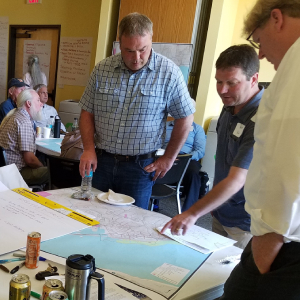Value planning is a powerful process for harnessing the knowledge of technical experts and engaging stakeholders. An innovation facilitator will guide your team and selected stakeholders through a carefully designed, creative problem-solving process.
More importantly, value planning is a specialized tool for capital project planners to use in making wise infrastructure plans, decisions, and project investments. You can use it for:
- Problem-solving, to encourage creative thinking a project’s early phases, when such thinking has the best chance to improve the project.
- Engaging stakeholders, so that their knowledge and perspectives are included, building a feeling of ownership for the project and buy-in to the selected solution.
- Managing risk, by identifying the right problem to solve, consider risks, and anticipate consequences, thereby preventing costly mistakes down the line.
- Conserving funding resources, by finding lower-cost but same level-of-service solutions, while creating community value and benefits for the natural environment.
HOW IT WORKS
Value planning is a special facilitated group process. Every part of the experience is designed to harness the knowledge and creativity of your people. The process works, because it uses proven methods drawn from design thinking, team innovation, creative problem-solving, LEAN, product design, and Agile and Sprint methods pioneered by industries that innovate as a matter of survival.
Typical value planning activities include, in order of delivery:
- Project orientation, team assembly, and stakeholder identification
- Advance research and data gathering by hand-picked experts
- Field trip, including a briefing book and worksheets
- Value planning workshop(s), including expert facilitation for the day(s)
- Further development of solution alternatives, using workshop results
- Solution alternatives report and action plan
NOT THE SAME AS VALUE ENGINEERING
Value planning and value engineering are based on the same idea: they seek to optimize value.However, they are two very different processes, which may be applied to the same project. To compare:
- Value Planning. This is a creative, participatory process that occurs in the early stages of a project. It’s purpose is to discover the real problem that needs solving and formulate the approach needed to solve that problem. At the core, the process generates alternatives for solving the problem and then chooses the best project approach. The people involved include the project owner, funder, planners and technical experts, operators, and community stakeholders. This process naturally takes place before designers and engineers start their work, and it considers a wide range of factors – including costs, benefits, long-term consequences, community benefits, and environmental benefits.
- Value Engineering. In contrast, value engineering occurs well into the design phase or construction phase. It is an independent design review process that seeks to optimize the beneficial outcomes of a project compared to the costs. The people who do value engineering are typically third-party engineers, architects, and contractors. Cost is usually the primary consideration.
WHEN TO USE VALUE PLANNING
Read the next blog about when to use value planning.
WORK WITH ME: Is your next project complex, costly, and a bit tricky? Value planning may be the tool to you need to navigate uncharted waters. Get in touch to talk about your goals and receive a detailed cost proposal.










